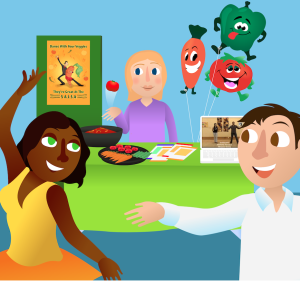Make a Great Nutrition Display in Three Easy Steps
 Nutrition Month means nutrition displays. Do you have the resources you need to stand out from the crowd?Part One: Location, Location, Location You want to make sure that your display is in an area that both draws high traffic and promotes lingering. Though the elevator might be full of people at all hours, the time limits it imposes make it an unappealing place for a display. By the same token, the room at the end of an untraveled hallway might have plenty of space but be unlikely to draw a crowd. Look instead for places that can draw a crowd and keep them there for a bit -- like the company lobby, a break room, a lunch area, etc. Of course, if you're setting up your display at a wellness fair or nutrition show, then you've already got a great location.Part Two: The Visuals Once you've got a great location, the next step is drawing people to your display. Visuals will be your "make or break." With a colorful, intriguing display, you can pique people's interest and bring them over to learn more. Once they're engaged, you can delve further into the information you're trying to communicate. What kind of visuals can you use? Consider the following...
Nutrition Month means nutrition displays. Do you have the resources you need to stand out from the crowd?Part One: Location, Location, Location You want to make sure that your display is in an area that both draws high traffic and promotes lingering. Though the elevator might be full of people at all hours, the time limits it imposes make it an unappealing place for a display. By the same token, the room at the end of an untraveled hallway might have plenty of space but be unlikely to draw a crowd. Look instead for places that can draw a crowd and keep them there for a bit -- like the company lobby, a break room, a lunch area, etc. Of course, if you're setting up your display at a wellness fair or nutrition show, then you've already got a great location.Part Two: The Visuals Once you've got a great location, the next step is drawing people to your display. Visuals will be your "make or break." With a colorful, intriguing display, you can pique people's interest and bring them over to learn more. Once they're engaged, you can delve further into the information you're trying to communicate. What kind of visuals can you use? Consider the following...
- A question on a banner. You want to ask something that your audience wants to know the answer to. Skip a dull title like "saturated fats" and instead ask a question like "What are Saturated Fats Doing to YOUR Heart?" Consider coming at the problem from a unique angle. For example "Is Chocolate a Health Food?" tends to draw a crowd because people genuinely want to know whether the answer is yes. Think about what will prompt your participants to... well... participate.
- A poster or two. A pop of color in an unexpected place really draws the eye. Posters offer a great way to communicate the absolute key messages that you want to get across, and do so by addressing several different learning styles. Consider including a chart or graph, a few key points about your topic, and an illustration.
Part Three: Follow Up You don't want to limit yourself to only the interest-grabbing visuals. Once people are drawn in by part two, often they will want to know more detail about the subjects you're addressing. That's where handouts, recipes, and scientific studies come in. Grab materials that go into more detail about your chosen topic and offer them to your audience.


